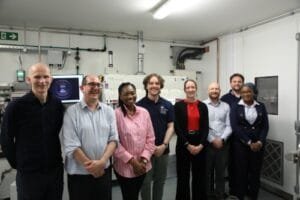What if your devices never needed a recharge? A groundbreaking innovation by scientists at the University of Bristol has introduced the world’s first nuclear-diamond battery, capable of powering devices for thousands of years. This revolutionary battery, powered by radioactive carbon-14 isotopes encased in diamonds, is not just a marvel of modern science but a potential game-changer across various industries, from medical technology to space exploration.
Nuclear-Diamond Battery, How Does It Work?
Unlike conventional batteries that rely on moving components like magnets or coils, the nuclear diamond battery uses the radioactive decay of carbon-14 isotopes embedded in a diamond to generate electricity. These isotopes emit short-range radiation that excites fast-moving electrons within the diamond structure, producing continuous energy. The process is remarkably similar to how photovoltaic cells in solar panels convert sunlight into electricity, except this battery captures electrons instead of photons.

What makes this technology even more impressive is its durability and safety. Diamonds, the hardest known substance on Earth, encase the radioactive material, preventing radiation from escaping. As a result, the battery is safe to handle and deploy, despite the inherent radioactivity of carbon-14.
In addition, the carbon-14 used in these batteries is sourced from graphite blocks found in nuclear power plants ensuring the process is both sustainable and environmentally friendly. Plus, the technology produces no carbon emissions and requires no maintenance due to the absence of moving parts.
Future of Energy: The Power of Longevity
The nuclear-diamond battery offers unprecedented longevity. With a half-life of 5,730 years, the carbon-14 isotopes powering the battery would take millennia to reach even 50% of their initial capacity. This means devices powered by this technology could potentially outlive civilizations, requiring no maintenance or replacements.
To put this into perspective, a single gram of carbon-14 can generate 15 joules of energy per day. While this output is lower than that of a standard AA battery in the short term, the nuclear-diamond battery’s longevity is unmatched. Where conventional batteries are exhausted in a matter of hours or days, this innovation can operate continuously for thousands of years.
Applications: From Pacemakers to Space Exploration
The versatility of the nuclear-diamond battery makes it a game-changer for various industries. It is especially suited for applications that demand longevity and reliability:
- Medical Devices: Pacemakers and X-ray machines can benefit from the consistently low power output, reducing the need for frequent replacements and minimizing invasive procedures.
- Space Exploration: Spacecraft powered by these batteries could traverse the cosmos for centuries without losing significant energy. For instance, a spacecraft heading to Alpha Centauri, our closest stellar neighbor, would still have most of its power intact upon arrival.
- Extreme Environments: Devices operating in hazardous or remote locations, like seabed oil rigs or radio-frequency tags for deep-space payloads, could rely on this technology to function flawlessly.
“We are excited to able to explore the possibilities, and we are working with industry partners and research for coming few year,” said Tom Scott, Professor in Materials at the University of Bristol said. “Our micropower technology can support a wide range of applications from Space technologies to security technologies through medical devices.”
What Lies Ahead?
Developed in collaboration with the U.K. Atomic Energy Authority (UKAEA), the nuclear-diamond battery is a product of cutting-edge research in fusion energy and plasma deposition technology. The team behind this innovation is now exploring partnerships with industries to adapt the technology for widespread use.
As Sarah Clark, Director of Tritium Fuel Cycle at UKAEA, aptly put it, “Diamond batteries offer a safe, sustainable way to provide continuous microwatt levels of power.” With this revolutionary technology, the world is stepping into an era where devices could last a lifetime—and beyond.
Challenges and Future Possibilities
While the nuclear-diamond battery excels in longevity, its current low power output limits its use to specific applications. Advancing this technology to power high-demand devices could unlock even greater potential, making it viable for powering homes, industries, and large-scale projects. Collaboration between researchers and industries will be crucial in overcoming these challenges.
The nuclear-diamond battery represents a seismic shift in energy technology. While its immediate applications focus on low-power devices, its potential to power our future is limitless. From extending the life of medical implants to enabling interstellar travel, this innovation could redefine the boundaries of what’s possible.

